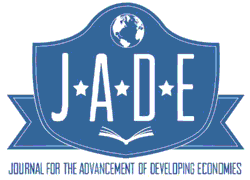Institute for the Advancement of Developing Economies

Journal for the Advancement of Developing Economies
Date of this Version
2016
Document Type
Article
Citation
Journal for the Advancement of Developing Economies, Volume 5, Issue 1 (2016), pp. 4-18.
doi:10.13014/K2NZ85VX
Abstract
In this paper, we combine Autoregressive Distributed Lag (ARDL) approach with trend analysis to assess the relationship between Ghana’s budget deficit and economic growth from 2000 to 2015 using quarterly data. The trend analysis reveals that since 2000, years of high budget deficit were usually followed by years of low economic growth and vice versa. This phenomenon was pronounced in 2009, when the Gross Domestic Product (GDP) growth rate fell from 7.3 percent in 2008 to 4 percent in 2009, following an increase in the budget deficit from 8 percent in 2007 to 11.5 percent in 2008. The same phenomenon was observed between 2012 and 2015. The econometric results show a significantly negative effect of budget deficits on economic growth. Thus, a 100 percent increase in budget deficit in the long run would lead to a 3 percent decrease in real GDP, holding all other factors constant. The results confirm the Neoclassical proposition that high budget deficit does not necessarily translate into economic growth. The paper recommends that government must ensure strong fiscal discipline without compromising the wellbeing of the citizenry by allocating budget spending to sectors that can translate the deficit into high economic growth both in the short and long runs.
Included in
Econometrics Commons, Growth and Development Commons, International Economics Commons, Political Economy Commons, Public Economics Commons, Regional Economics Commons


Comments
Copyright 2016 JADE